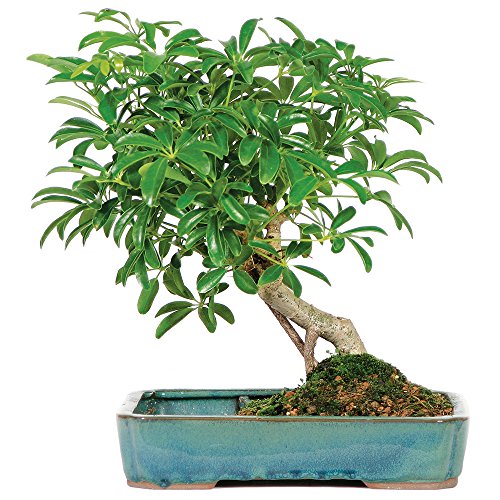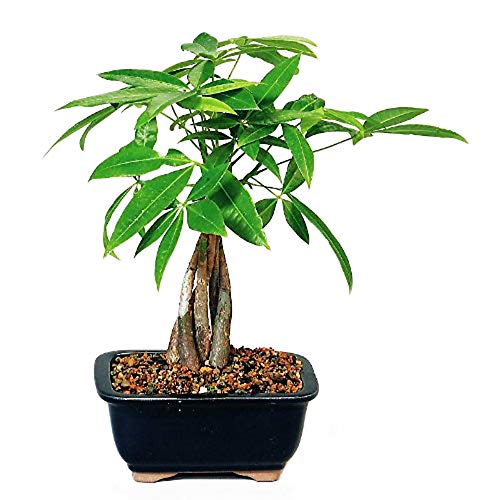This page may contain affiliate links. If you click and buy, we might get a small commission at no cost to you.
A Bonsai tree is a unique addition to your common house plants. The carefully cultivated miniature trees bring beauty, peace, and serenity to any space. It’s one of the reasons the small potted trees are becoming commonplace in the office and at home. However bringing a tree that grows outdoors in the wild inside can be tricky, some varieties will just naturally do better outdoors. So in this article we’ll look specifically at some of the best indoor bonsai tree species.
These trees do need care that includes pruning to maintain a sculpted, yet natural state. It’s the precise pruning that makes the trees so relaxing and satisfying. You can instantly see the results of your care.
If you’re considering a Bonsai tree, here’s a list of some that are among the more popular indoor options.
Best indoor bonsai tree species
Bonsai trees aren’t limited to a few varieties. Everything from Ficus and Jade plants to Elm and Maple trees can be pruned into a Bonsai tree. However some do much better indoors than others. In the below list I’ll show you 8 bonsai trees known for doing exceptionally well inside.
1. Ficus bonsai
Scientific name: Ficus Retusa and Ficus Microcarpa
Average lifespan: 200 years
Best for: Beginners
The Ginseng Ficus, or Ficus retusa, is native to Southwest Asia and are one of the hundreds of species in the Ficus family. It is a tropical evergreen and does not do well in cold drafts or temperatures. The miniature trees also don’t like sudden changes to their environment. They need plenty of sunlight, though bright afternoon light can burn the tree’s delicate leaves. Ficus are fast growers and need regular pruning throughout the year.
The Golden Gate Ficus, or Ficus microcarpa, is part of the Ficus family and is native throughout the Pacific, including Australia and New Caledonia. It is a fast grower, even as a miniature, and requires frequent pruning. You do want to do the heavy pruning in the spring before the new growth appears. The trees love sunlight and hate cold temperatures. Keeping the leaves dusted will help the tree keep its brilliant green foliage.
Buy Golden Gate Ficus on Amazon
Both of these ficus variants are commonly sold as bonsai and look very similar. Both also make great indoor bonsai trees, especially for beginners.
2. Dwarf Jade bonsai
Scientific name: Crassula Ovata
Average lifespan: 100 years
Best for: Easy Care
Dwarf jade plants are native to South Africa and prefer drier growing conditions. The trees are naturally short, seldom reaching over 10’ in height, making the plants ideal as an indoor bonsai tree. They require little pruning, only a few times a year for shape. The easiest way to kill a dwarf jade tree is by overwatering. The plants only need a little water in the spring and summer. During the autumn and winter, only water when the container is completely dry.
Buy Dwarf Jade Bonsai on Amazon
3. Juniper
Scientific name: Juniperus Chinensis
Average lifespan: 100 years
Best for: Creative Shapes
Part of the Cypress family, Junipers are popular bonsai trees. The plants are easy to care for, though they do need the right amount of water, light, and humidity. What makes the evergreens so popular is their ability to be pruned into creative shapes. The branches are flexible and easy to train over time with wire and careful pruning. The trees do need at least 4 hours of sunlight per day and water only when the soil is dry.
The Juniper is commonly sold as an outdoor bonsai tree, and does go into winter dormancy. It can however be kept indoors part of the year making it a highly popular indoor/outdoor bonsai tree.
Check out the reviews on Amazon from people successfully keeping this variety as an indoor tree.
4. Chinese Elm
Scientific name: Ulmus Parvifolia
Average lifespan: 50 -150 years
Best for: Partial Shade
Native to Southeast Asia and China, the Chinese Elm is a hardy plant that will tolerate full sun or partial shade. It’s also cold-weather hardy, though the plant will lose its leaves when temperatures drop close to freezing. Chinese Elms are fast growers and need frequent trimming, especially if you want the tree to keep its shape. Frequent watering is another requirement. The small trees quickly dry out.
5. Japanese Maple
Scientific name: Acer Palmatum
Average lifespan: 100 years
Best for: Flowering
Popular as shade trees, and native to China, Korea, and Japan, the plants are also popular bonsai. In the spring, small greenish-yellow flowers appear in clusters. Even though it is a hardy tree, Japanese Maples still require a lot of care. During the growing season, the plant requires daily watering. You also want to keep it out of direct sunlight to avoid burning the delicate leaves. Major pruning is done in the summer or fall, though you can keep it neatly trimmed throughout the year.
6. Hawaiian Umbrella
Scientific name: Schefflera Arboricola
Average lifespan: 25 – 50 years
Best for: Rock Gardens
The Hawaiian Umbrella plant is a hardy plant that grows in subtropical regions. The plant’s root system is similar to mangroves, making it ideal as a rock bonsai. The small, dark green leaves resemble umbrellas, and with the right care, the tree produces black and orangish-red berries in the spring. It does need a lot of sunlight to prevent the leaves from wilting. You also want to water it sparingly, without letting the soil dry out.
Buy Hawaiian Bonsai Tree on Amazon
7. Money Tree
Scientific name: Pachira Aquatica
Average lifespan: 10 – 30 years
Best for: High Humidity
Part of the Malvaceae plant family and native to Central America, the Money Tree needs plenty of humidity to thrive. It also does not tolerate cold temperatures, below 54°F. Heavy pruning is done in the winter before new growth appears. Watering is done sparingly to avoid damaging the root system. The plants also need weekly fertilizing from spring through autumn. The tree does produce flowers in the spring with the right care.
How to Choose a Bonsai Tree
Bonsai trees are popular houseplants. Their unique shapes ensure they stand out from the rest of your greenery. They are also fun and relaxing plants to care for. Almost any tree can be a bonsai, and this means their care differs. Some require daily attention, while others you only need to tend once a week. Here are a few things to consider when you’re picking out a bonsai.
Amount of Care
If you don’t have a lot of time to spend taking care of a bonsai, you don’t want one that needs daily watering or frequently pruning. You also want to check how often the plant needs fertilizer and the type. Your average temperature indoors, along with the amount of sunlight, are other factors to think about before you bring a bonsai tree home.
Care also applies to how familiar you are with plants. If you don’t have a green thumb, and it’s your first bonsai tree, you want one that is hardy and easy to grow.
Size
Some bonsai trees only grow to around 4” while others are much taller. Think about where you’re going to put the tree and the amount of space it has to grow. A tiny bonsai will be overwhelmed in a large space. One that is too big for your space will start to grow at odd angles, possibly damaging the trunk or branches.
Pick a Healthy Plant
Even an experienced bonsai grower will have problems with an unhealthy plant. To ensure that you’re starting with a healthy miniature tree, you want to look for a few things.
- The roots should stick slightly out of the soil, but still securely anchored to the pot. Loose or sunken roots are often a sign of a weak plant.
- When you’re looking at the trunk, make sure it’s smooth. Defects can affect the tree’s health. You also want the tree trunk thicker at the bottom and narrower on top. Not only does it look better, but it also helps prevent the tree from becoming unbalanced.
- A healthy bonsai has branches that don’t cross over each other. The branches are also evenly spaced along the trunk to match the tree’s shape.
- Leaves will give you the first indications that a bonsai isn’t healthy. You want the leaves uniformly green, without any discoloration or appearance of drying out.
Conclusion
Growing and caring for a bonsai tree is a Zen-like experience. It’s both relaxing and satisfying to watch your little tree take shape. There are several varieties of bonsai trees, and each has unique characteristics. Some are easy to prune into interesting shapes, and others will bloom for you in the spring.
Along with making sure you choose a healthy bonsai, you also want one within your skill level. If this is your first bonsai, don’t choose one that needs a lot of care. Instead, pick one that will still thrive even if you make a couple of mistakes.









